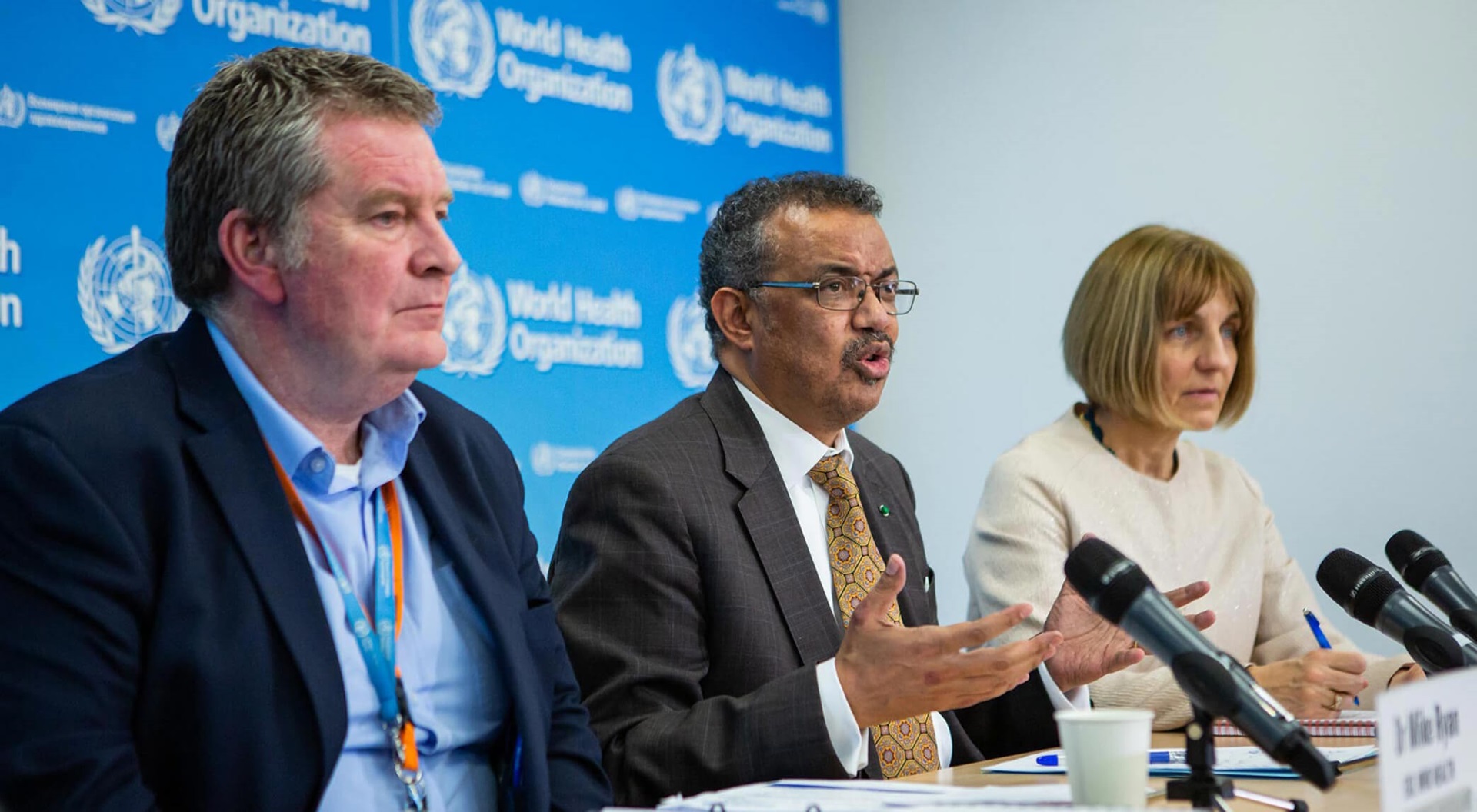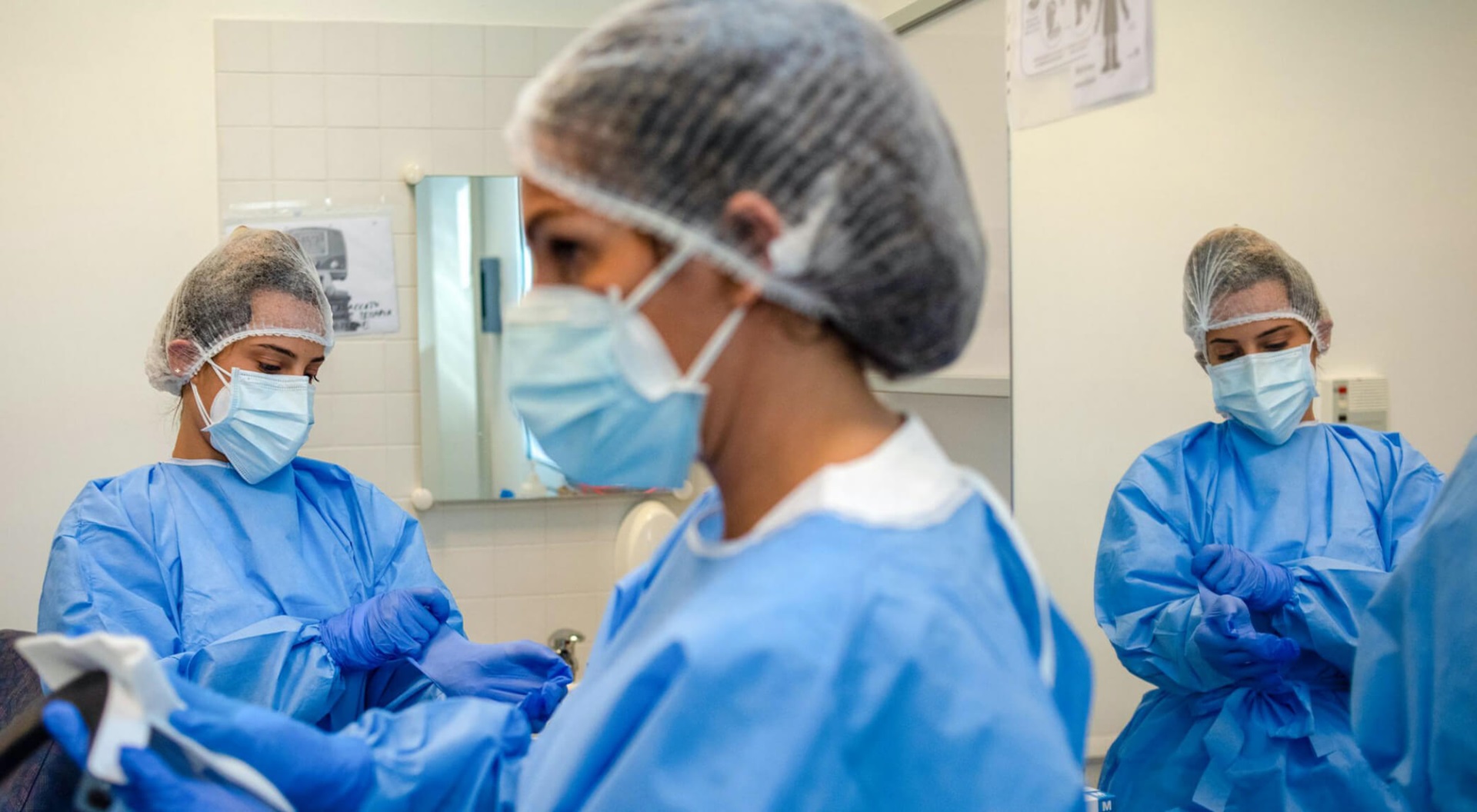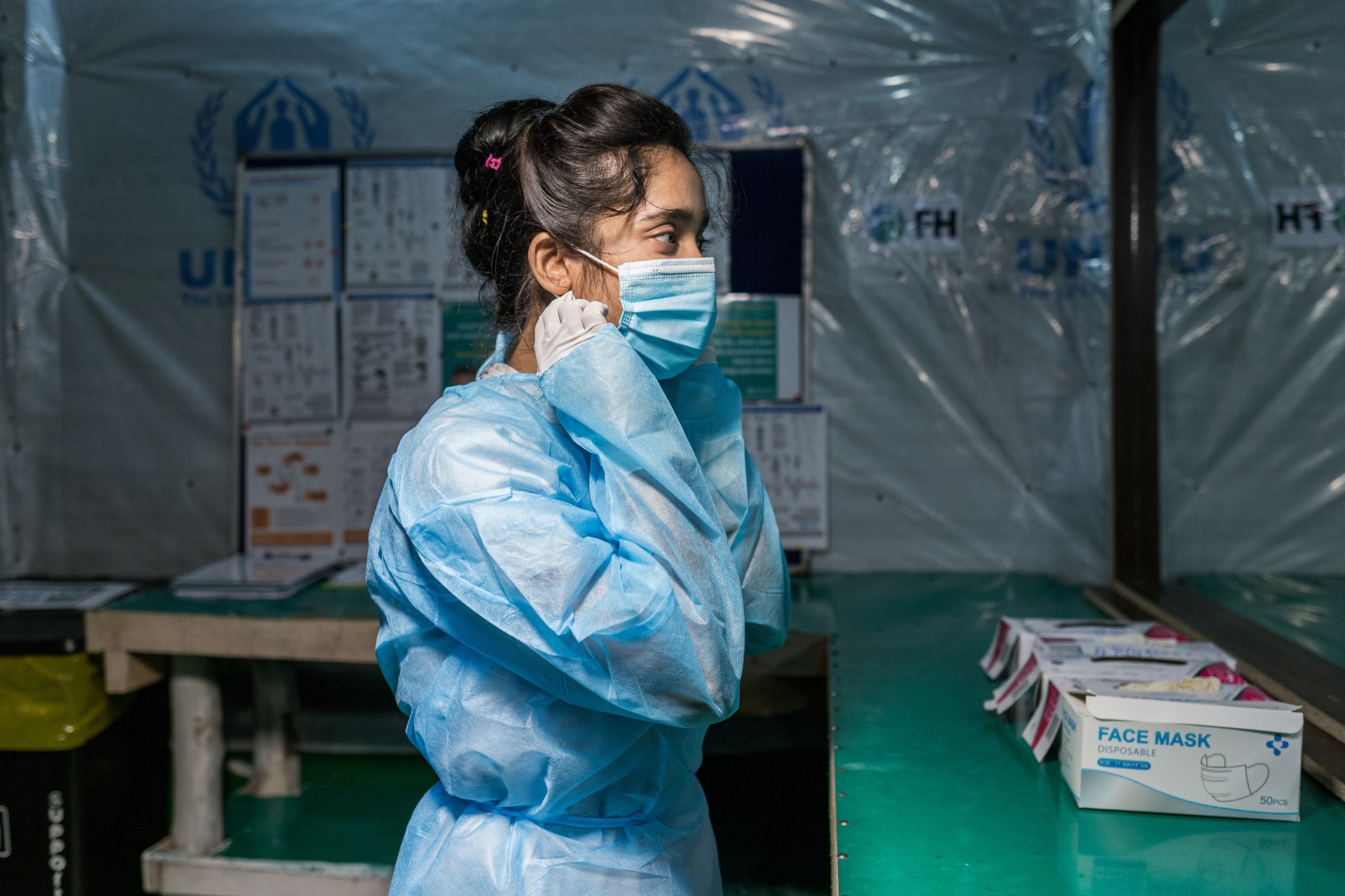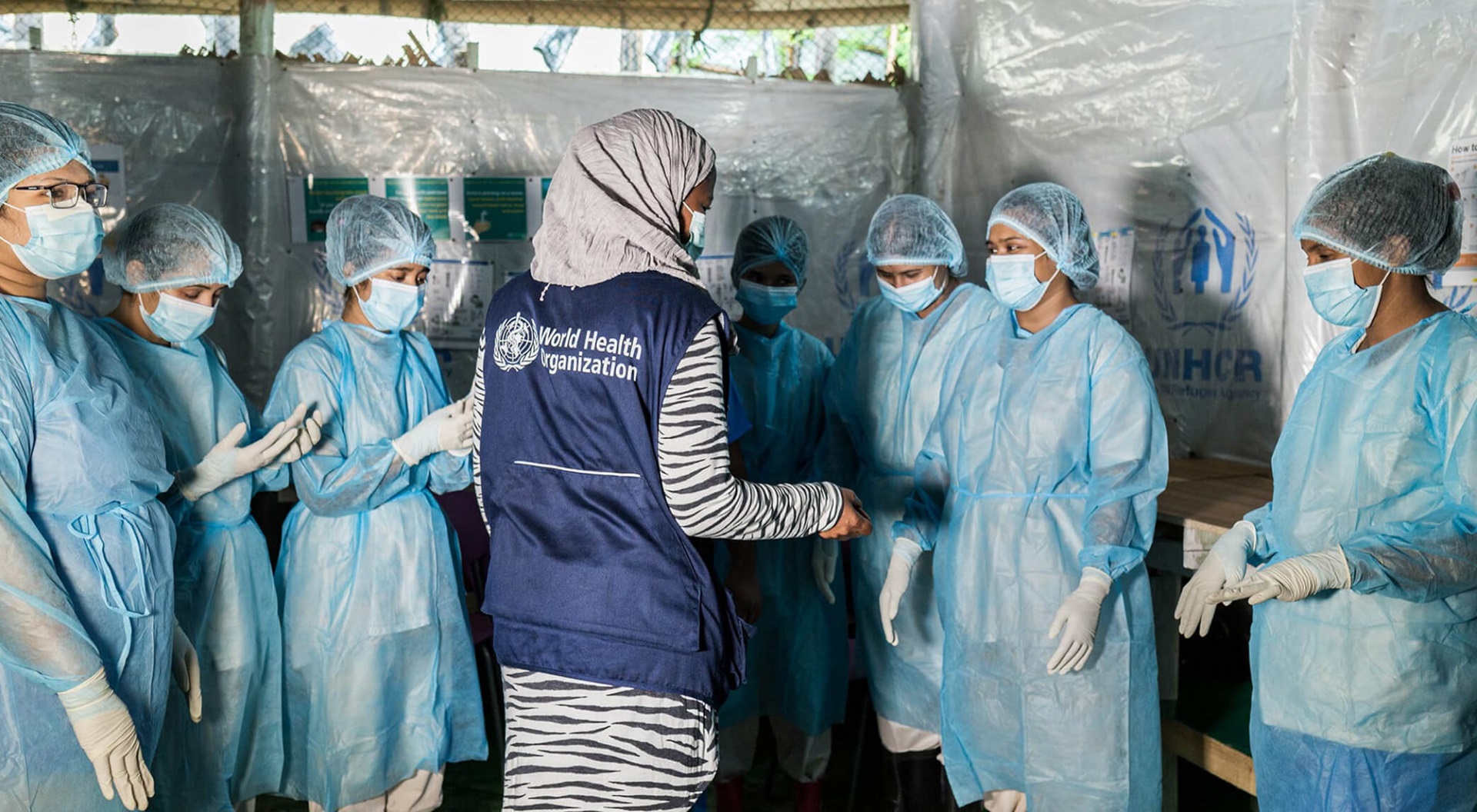WHO: The world's guiding light in health emergencies
COVID-19 has taken millions of lives, sent economic shockwaves around the world, exacerbated inequalities and frayed the social fabric of communities and countries on a global scale. There are few precedents for responding to a catastrophe of this scale. COVID-19 has shown that a multilateral system of global governance – of which WHO is part – based on shared values and solidarity, is needed now more than ever. WHO plays a vital role as a moral leader, and as the technical and operational health authority for the world.
WHO’s response to COVID-19 has been its fastest and most far-reaching to a health emergency. The Organization has led, convened and coordinated from day one of the outbreak, bringing partners together and scaling up the Organization’s own technical and operational capacity across more than 150 country offices and six regional offices to help save lives and protect the vulnerable.
The response of WHO and Member States to COVID-19 has drawn on many capacities and platforms that were set up in response to previous health emergencies. It is vital that the lessons learned from COVID-19 inform and guide the next evolution of WHO’s and the world’s capacity to prepare for, prevent, detect and respond to major health crises. One lesson is already very clear: the world needs a strong WHO with the resources, support and authority not only to guide the continuing response to COVID-19 but to shape the future of global health emergency protection.
The world’s early warning system
Early detection, rapid risk assessment and clear communication are the foundations of an effective response to any health emergency. The first sign of the emergence of COVID-19 was detected on the final day of 2019. Within 24 hours WHO had activated its Incident Management Support Team (IMST) across the three levels of the Organization. On 5 January 2020, WHO shared detailed information and risk analyses about the cluster of cases with all Member States through the International Health Regulations Event Information Site (EIS), and published a public Disease Outbreak News alert. Several days later, WHO reported that the cluster had been caused by the novel coronavirus that we now know as SARS-CoV-2, and on 30 January the Director-General accepted the International Health Regulations (2005) (IHR) Emergency Committee’s advice and declared the COVID-19 outbreak a public health emergency of international concern (PHEIC), WHO’s highest level of alarm. Ever since that first sign was detected, WHO has kept the world informed of every epidemiological development and has worked rapidly through its regional and national offices to strengthen health emergency information management at the country level.
Within 24 hours WHO had activated its Incident Management Support Team
Improving the timeliness and quality of data available to the public and decision-makers at national, regional and global level not only improves the speed and precision of the COVID-19 response but has broader public health benefits. The COVID-19 pandemic has acted as a catalyst, enabling WHO to accelerate the roll-out of core public health surveillance tools that will leave a legacy of benefit beyond COVID-19. The expansion of the Epidemic Intelligence from Open Sources (EIOS) system, for example, has broadened the scope of global public health surveillance at the same time as streamlining and foreshortening the time it takes to validate and assess alerts. Throughout 2020 the EIOS system enabled WHO to sift through hundreds of thousands of potential signals every day. The system picked up 26 million signals related to COVID-19 during 2020.

WHO
Guiding the world with evidence
As a technical organization with convening power, access to world-leading expert networks, collaborating centres and collaborative research and innovation platforms such as the R&D Blueprint for Action to Prevent Epidemics, WHO works with partners to generate high-quality evidence and leverage a broad range of global expertise to guide each technical and operational area of health emergency preparedness, readiness and response. Crucially, by driving coordination between United Nations national and regional offices around the world, multi-agency and -partner operational platforms, regional and national public health and scientific institutes, communities, donors and private sector organizations, WHO has been able to bring the world together to put that guidance into action during the response to COVID-19.
WHO’s prior work and access to in-house expertise on coronaviruses gave the Organization a head start when it came to translating knowledge into action. The Organization published its first package of technical guidance, covering topics from infection prevention and control to laboratory testing, on 10 January 2020 – just one day after a novel coronavirus was identified as the cause of the initial cluster of cases. On 13 January, just days after the full genome sequence of the virus had been made available, WHO published the first protocol for a PCR assay to test for the SARS-CoV-2 virus, and immediately began working with companies to produce high-quality PCR kits that were shipped to laboratories worldwide in early February 2020. In addition to guidance and tools, WHO also rapidly launched online training in January to augment its direct technical support and ensure that health workers were ready to put tools and guidance into action safely and effectively.
On 13 January, just days after the full genome sequence of the virus had been made available, WHO published the first protocol for a PCR assay to test for the SARS-CoV-2 virus
In total, WHO published over 800 COVID-19-related documents during 2020, leveraging its core normative strength to rapidly gather and synthesize evidence and data into authoritative guidance, with support for its implementation and adaptation in every context delivered through regional and country offices.
“We cover the entire spectrum of public health, from cutting-edge science down to implementation. Very few agencies can do it. We can do it because we have the country presence,” explained Dr Sylvie Briand, Director of WHO’s Infectious Hazards Management Department. WHO’s global footprint also enables it to multiply the power of the evidence collected by individual countries by helping to standardize and improve methods of data collection, thus ensuring that data on the epidemiological and clinical aspects of COVID-19 are representative of a broad cross-section of the global population. “We can get countries to collect data in one way to make cohesive evidence-based conclusions,” said Dr Briand.
WHO has always worked with partners, leveraging collective individual and institutional knowledge from around the world through expert committees, networks and an expanding list of more than 800 WHO Collaborating Centres.
“We don’t develop guidance alone but with partners. We harness the world’s expertise,” said Dr Maria Van Kerkhove, WHO’s COVID-19 technical lead. Her multidisciplinary technical “team” extends to thousands, she says, and includes frontline clinicians, virologists and epidemiologists from every corner of the globe. These relationships, many built over years, helped accelerate developments in the response.
As with many aspects of WHO’s work, COVID-19 meant changing the way the Organization interacted with and convened global expertise, using new communication platforms to extend its reach beyond traditional partnerships. “We reached people in more corners of the earth. They weren’t limited by visas and travel,” said Dr Van Kerkhove. “The expansion of our networks is not just in geographic reach but also at subnational level. And we work with more disciplines now, even architecture and aerobiology.”
WHO’s ability to bring the world together is even more important during emergencies, where rapid knowledge sharing can have immediate benefits in terms of lives saved. For example, early in the pandemic, WHO enabled clinicians in Wuhan to confer with clinicians from Saudi Arabia experienced in treating MERS. That knowledge-sharing process was faster than any pre-print or peer reviewed publication.
“We’re the connector and driver. We’re like a spider in the web pulling all of this together.” said Dr Van Kerkhove.
WHO’s online learning platform, OpenWHO, had reached five million learners by the end of 2020, most of whom registered for free online COVID-19 courses in more than 50 languages. The platform, launched in 2017, shows that WHO can launch fast, high-quality, accessible learning on a massive scale to bolster the management of a health threat. In total, 143 courses were produced to support the COVID-19 response. The most popular, the technical guidance course Introduction to COVID-19: methods for detection, prevention, response and control, received over 1.1 million total enrolments across 36 language versions. OpenWHO has been recognized for its achievements with several awards.

WHO
Driving scientific development, delivering equitably for the world
The beginning of 2020 saw SARS-CoV-2 emerge as a new zoonotic disease of which the world had little scientific and clinical understanding, and for which it had no medical countermeasures. By the end of 2020, the world had already administered the first doses of the first generation of safe and effective vaccines; had a funding mechanism designed to ensure everyone in the world had access to an effective vaccine on the basis of need; had a clear understanding of the public health and social measures that could keep transmission of SARS-CoV-2 under control; had learned how to treat COVID-19 more effectively; had established and leveraged the new discipline of infodemiology to study how access to public health information (and misinformation) shapes public health outcomes; and had new tools and strategies to track transmission of SARS-CoV-2 and detect variants of concern in a wide variety of settings. None of these achievements belongs to WHO alone, but all had WHO at their heart.
WHO's technical capacity, convening power, expert networks and years spent laying the foundations for research during health emergencies enabled it to shape and accelerate the research agenda for COVID-19.
WHO’s technical capacity, convening power, expert networks and years spent laying the foundations for research during health emergencies enabled it to shape and accelerate the research agenda for COVID-19. In January 2020, WHO activated the R&D Blueprint, which was established in 2015 in response to lessons learned from the Ebola virus disease outbreak in West Africa and other recent outbreaks, with the aim of strengthening coordination between scientists and global health professionals, accelerating the research and development process during emergencies and catalysing research and innovation in preparation for future emergencies. The first task of the Blueprint team was to bring stakeholders together to set priorities for accelerated research and devise a framework to ensure that its results were implemented as widely, accessibly and as equitably as possible. The Coordinated Global Research Roadmap: 2019 Novel Coronavirus, published following this first global COVID-19 research forum in February 2020, set out nine key areas for accelerated research and development, ranging from medical countermeasures such as vaccines, therapeutics and diagnostics to virus transmission and origin, and including clinical management, infection prevention and control, and social scientific studies of the impact of and response to COVID-19.
WHO’s role goes beyond setting priorities for accelerated research: it extends to setting up and leading clinical trials, evaluating the results of trials of vaccines, diagnostics and therapeutics and approving products for emergency use, and ensuring that countries not only have access to these approved products but the capacity to implement them safely and effectively. The Solidarity Trial, which evaluates the effects of different treatments on overall mortality, initiation of ventilation and duration of hospital stay, is the largest clinical trial of candidate COVID-19 therapeutics, recruiting over 12 000 patients at 500 participating hospitals in 30 countries during 2020. The Solidarity Trial shows that large-scale international trials are possible even in a pandemic, producing statistically significant results in the shortest possible time; the same methods will be applied to study COVID-19 vaccines throughout 2021. The major challenge for 2021 and the years beyond will be to ensure that the fruits of COVID-19 research, and vaccines in particular, are distributed fairly and that countries have the infrastructure to implement all COVID-19 tools. To achieve this goal, WHO and partners established the Access to COVID-19 Tools (ACT) Accelerator in April 2020.
12 000
Patients enrolled in 500 hospital sites in over 30 countries, through the Solidarity Trial for therapeutics.
The Access to COVID-19 Tools (ACT) Accelerator, launched in April 2020 by WHO and partners, is a special project that musters the expertise of leading public health agencies, donors and private sector partners to focus on a specific and urgent strategic objective of WHO’s Strategic Preparedness and Response Plan: to accelerate the development of COVID-19 vaccines, diagnostics and therapeutics, and ensure equitable access to these new tools. ACT Accelerator workstreams have been merged with WHO’s Incident Management System (IMS) structure, and made a part of the broader Strategic Preparedness and Response Plan 2021, to ensure that access to new products is accompanied by their safe, equitable and effective implementation within strong and resilient national health systems that can also provide essential services.
WHO plays a vital role in coordinating the overall work of ACT-A, running the ACT-A Hub and leading the Access & Allocation workstream. Across the products pillar (diagnostics, therapeutics and vaccines), WHO supports research and development, generates essential norms and standards, develops critical policy and technical guidance, ensures regulatory capacity building and pre-qualification services and provides deep technical assistance for national readiness. Together with Gavi and the Coalition for Epidemic Preparedness Innovations, WHO co-leads COVAX, the vaccines pillar of the ACT-A which aims to ensure that no countries are left behind in the rush to roll out vaccines.
In April 2021 WHO and partners announced that than one hundred countries have received life-saving COVID-19 vaccines via the COVAX pillar of the ACT-A. This milestone comes 42 days after the first COVAX doses were shipped and delivered internationally to Ghana on 24 February 2021. The COVAX initiative has now delivered more than 38 million doses across six continents, supplied by three manufacturers: AstraZeneca, Pfizer-BioNTech and the Serum Institute of India (SII). Of the over 100 countries reached, 61 are among the 92 lower-income economies receiving vaccines funded through COVAX. Despite reduced supply availability in March and April – the result of vaccine manufacturers scaling up and optimizing their production processes in the early phase of the roll-out, as well as increased demand for COVID-19 vaccines in India – COVAX expects to deliver doses to all participating economies that have requested vaccines in the first half of the year.

WHO/L. Mackenzie
Steering a global operational response
At the global level, meeting the challenge of COVID-19 has meant bringing the entire United Nations system together to coordinate a response that reflects the full spectrum of its capabilities. WHO is at the forefront of that coordination process, leading the UN Crisis Management Team (UNCMT) to deliver three distinct but complementary strategies and frameworks. In addition to WHO’s direct technical support and operational support, with many hundreds of missions to strengthen critical national and subnational functions during 2020, its Emergency Medical Teams (EMT) initiative and the Global Outbreak Alert and Response Network (GOARN) provide countries with access to a rapidly deployable, flexible and multidisciplinary health emergency workforce.
To help countries put their own tailored COVID-19 national response plans into action and fill critical gaps in capacities and resources, WHO designed an innovative online platform to plan, track and fund country plans, bringing together donors, partners, UN agencies and governments to work and collaborate on a single platform. By the end of 2020, the Partners Platform was being used by 147 Member States, more than 600 partner entities and 77 donors, and tracking over US$ 9.1 billion of requested resources.
WHO Partners Platform usage by end of 2020
Across all pillars of the response to COVID-19, WHO was able to scale up and leverage existing and new operational and partnership platforms to translate the Organization’s evidence-based technical knowledge and know-how into tangible impacts at national and subnational level. The WHO-led COVID-19 Supply Chain System is a perfect illustration of this end-to-end integration of technical and operational capacities for impact. Starting with technical specifications and quality assurance from WHO’s technical experts, through procurement and distribution, to leveraging of WHO and partners’ logistics capabilities and joint purchasing power, the Organization was able to procure and ship more than US$ 1 billion of essential response supplies including vital medical oxygen, personal protective equipment and more than 250 million COVID-19 tests to 184 countries during 2020.
In February 2020, as COVID-19 began to spread more widely, severe strains began to ratchet up on global supply chains for commodities that were essential for the response. Even as demand was surging for key personal protective equipment items, medical supplies and laboratory consumables, supply chains were hit by border closures, trade restrictions and lockdowns that impacted manufacturing capacity. When supply chains ground to a halt, prices spiked and normal market conditions collapsed. Panic buying, hoarding and profiteering meant that many countries were locked out of the market, while those with access were often offered substandard supplies.
It was an unprecedented situation. Initially, WHO organized the rapid deployment of supplies from existing inventories, but it was clear that an effective and sustainable solution would require market intervention on a global scale to ensure that essential supplies were available based on need rather than purchasing power. The COVID-19 Supply Chain System (CSCS) was the solution, set up to harness the technical expertise, market and procurement know-how, joint purchasing power and logistical expertise of WHO and UN partner agencies, manufacturers, suppliers and Member States.
The CSCS sourced, validated and delivered over US$ 1 billion worth of essential, quality-assured supplies throughout 2020. Crucially, over 50% of essential supplies obtained by low-income and middle-income countries during 2020 were obtained through the CSCS.

WHO, Blink Media/F. Monir
Fighting the COVID-19 infodemic
The speed and scale with which COVID-19 medical countermeasures were developed was a major success story of 2020, but WHO and partners also developed a new discipline within the emergency response: the multidisciplinary field of infodemiology. This entailed the development of infodemic management tools to better understand how health information is used and consumed by communities, how that process translates into behavioural changes and therefore how best to intervene in that process to improve health outcomes. In 2020 WHO’s infodemic management team developed the Early AI-supported Response with Social (EARS) listening tool, which allows health decision-makers to view a real-time analysis of trending narratives about public health topics that are popular in public online forums, in multiple countries and languages. The tool enables policy makers to gain a rapid and real-time understanding of the concerns of the public and adjust policy accordingly. Unlike other proprietary social-listening tools, EARS is free of charge and can be used in contexts with insufficient budgets to invest in infrastructure and software. It promises to hone the response not only to COVID-19 but to future health emergencies.
The WHO Information Network for Epidemics (EPI-WIN), which unites technical and social media teams to counter misinformation, runs a weekly study using digital media to identify key concerns from online conversations, picking out misleading sources, posts and narratives, and refining appropriate risk communication messages. In addition to the traditional idea of communities based on geographies or online spaces, WHO also works with communities of practice, and has established relationships with faith leaders, business groups, trade unions and education networks among others. Communities are at the centre of WHO’s response to COVID-19, and the approach to infodemic management is no different. “Epidemics start with communities and stop with them,” said Dr Briand.
Epidemics start with communities and stop with them.
Dr Sylvie Briand
Director of WHO’s Global Infectious Hazard Preparedness Department

WHO, Blink Media/F. Moni
Advocating health for all, for a healthier more equitable future
We are now confronted by a world altered by COVID-19, one that presents both challenges and opportunities for progress towards one billion people better protected from health emergencies. This is now a world in which epidemics of vaccine-preventable diseases may become more common in the short term owing to interruptions and delays in the provision of immunization services and disruptions to surveillance systems. Vital health services have been stretched to breaking point around the world. The ability of governments and vulnerable communities to cope with economic shocks has been undermined. Issues driving conflict have been magnified. The risk of natural disasters has increased against the backdrop of an accelerating climate emergency. Changes in land use, animal husbandry and the continued degradation and destruction of natural ecosystems increase the likelihood that pathogens will follow the path of SARS-CoV-2, HIV, Zika, SARS-CoV-1, Ebola virus and pandemic influenza viruses and cross the species barrier into human populations.
It's time to forge a new era of cooperation that puts health and well-being at the centre of our common future. The world has reached a fork in the road.
Dr Tedros Adhanom Ghebreyesus
WHO Director-General
The factors that collude to heighten the risk of health emergencies are also more likely to make responding to those emergencies more challenging. This new world clearly needs a rekindled collective commitment to give it the requisite tools to prepare for, prevent, detect and respond to health emergencies.
WHO has long been a moral voice, advocating for the health of the world’s people. Equity, access to health and universal health coverage are at the core of WHO’s mission. The notion of “health for all” through primary health care dates back to the 1978 Declaration of Alma-Ata, and resonates as a goal more loudly than ever now in the COVID-19 setting.
On 30 March 2021, WHO Director-General Dr Tedros Ghebreyesus joined global heads of state in calling for an international treaty to capture the renewed collective commitment to pandemic preparedness at the highest political level, as established in WHO’s constitution and underpinned by the IHR, and to support the principle of health for all.
The main goal of such a treaty would be to foster an all-of-government and all-of-society approach, to strengthen national, regional and global capacities and to nurture resilience to future pandemics. This would include a considerable enhancement of international cooperation to improve alert systems, data-sharing and research and to boost the local, regional and global production and circulation of medical and public health countermeasures.
COVID-19 exploited the world’s weaknesses and divisions, but it has also provided us with an opportunity to come together as a global community, in solidarity, to build the health emergency capacities and systems fit for generations to come.
